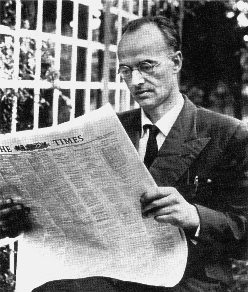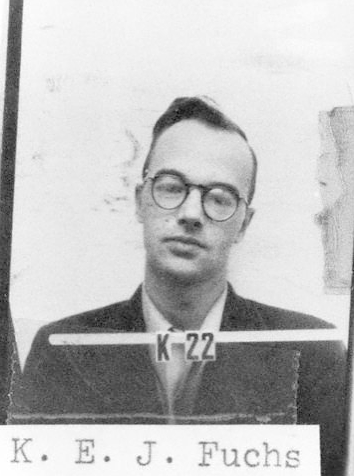<Back to Index>
- Mathematician Kurt Wilhelm Sebastian Hensel, 1861
- Writer and Queen Consort of Romania Carmen Sylva (Pauline Elisabeth Ottilie Luise zu Wied), 1843
- Physicist and Atomic Spy Klaus Emil Julius Fuchs, 1911
PAGE SPONSOR
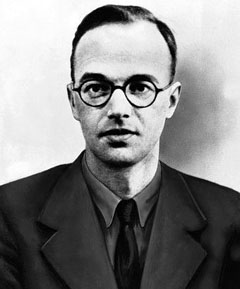
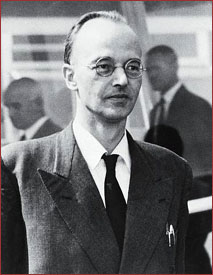
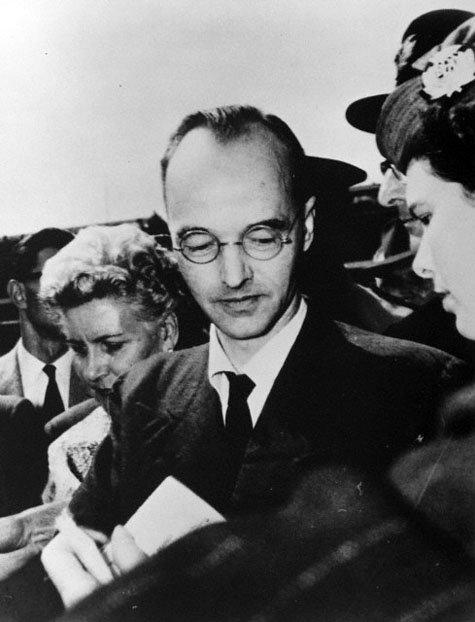
Klaus Emil Julius Fuchs (29 December 1911 – 28 January 1988) was a German theoretical physicist and atomic spy who in 1950 was convicted of supplying information from the American, British and Canadian atomic bomb research (the Manhattan Project) to the USSR during and shortly after World War II. While at the Los Alamos National Laboratory, Fuchs was responsible for many significant theoretical calculations relating to the first fission weapons and later, the early models of the hydrogen bomb, the first fusion weapon.
Klaus Fuchs was born in Rüsselsheim, Grand Duchy of Hesse, the third of four children to Lutheran pastor Emil Fuchs and his wife Else Wagner. Fuchs' father was later a professor of theology at Leipzig University. He became an active Quaker, both in Germany, England, and in the United States. Fuchs' grandmother, mother, and his older sister eventually committed suicide (his mother in c.1932, his sister in 1939 to avoid capture by the Nazis), while his younger sister was diagnosed as schizophrenic.
Fuchs attended both Leipzig University and Kiel University, and while at Kiel became active in politics. He joined the Social Democratic Party of Germany and, in 1932, the Communist Party of Germany. In 1933, after a violent encounter with the recently installed Nazis, he fled to France and was then able to use family connections to flee to Bristol, England, arriving September 24, 1933. He earned his Ph.D. in Physics from the University of Bristol in 1937, studying under Nevill Mott, and took a DSc at the University of Edinburgh while studying under Max Born. His paper on quantum mechanics, published in the Proceedings of the Royal Society in 1936, helped win him a teaching position at Edinburgh the following year.
At the outbreak of war, German citizens in Britain were interned. Fuchs was put into camps on the Isle of Man and later in Quebec, Canada, from June to December 1940. However, Professor Max Born intervened on Fuchs' behalf. By early 1941, Fuchs had returned temporarily to Edinburgh. He was approached by Rudolf Peierls of the University of Birmingham to work on the "Tube Alloys" program – the British atomic bomb research project. Despite wartime restrictions, he was granted British citizenship in 1942 and signed an Official Secrets Act declaration form.
A London message from the GRU, the Red Army's foreign military intelligence directorate, dated 10 August 1941, refers to the GRU reestablishing contact with Fuchs. His initial Soviet contact was known as "Sonia". Her real name was Ruth Werner – a German communist and a Major in Soviet Military Intelligence.
As Fuchs later testified, after Nazi Germany invaded the Soviet Union in 1941 he concluded that the Soviets had a right to know what the United Kingdom (and later the United States) were working on in secret. Hence he began transmitting military intelligence to the USSR, though the historical record is unclear about exactly when he started. Fuchs's testimony confirms that he contacted a former friend in the Communist Party of Germany, who put him in touch with someone at the Soviet embassy in Britain. His codename was Rest.
In late 1943, Fuchs transferred along with Peierls to Columbia University, in New York City, to work on the Manhattan Project. Although Fuchs was "an asset" of GRU in Britain, his "control" was transferred to the NKGB when he moved to New York. From August 1944 Fuchs worked in the Theoretical Physics Division at Los Alamos, New Mexico, under Hans Bethe. His chief area of expertise was the problem of imploding the fissionable core of the plutonium bomb. At one point, Fuchs did calculation work that Edward Teller had refused to do because of lack of interest. He was the author of techniques (such as the still used Fuchs - Nordheim method) for calculating the energy of a fissile assembly which goes highly prompt critical. Later, he also filed a patent with John von Neumann, describing a method to initiate fusion in a thermonuclear weapon with an implosion trigger. Fuchs was one of the many Los Alamos scientists present at the Trinity test.
From late 1947 to May 1949, Fuchs gave Alexander Feklisov, his case officer, the principal theoretical outline for creating a hydrogen bomb and the initial drafts for its development as the work progressed in England and America. Meeting with Feklisov six times, he provided the results of the test at Eniwetok atoll of uranium and plutonium bombs and the key data on U.S. production of uranium - 235. By revealing that America was producing one hundred kilograms of uranium - 235 and twenty kilograms of plutonium per month, Fuchs made it easy for Soviet scientists to calculate the number of atomic bombs the United States possessed.
Thus, because of Klaus Fuchs, leaders of the Soviet Union knew the United States was not prepared for a nuclear war at the end of the 1940s, or even in the early 1950s. The information Fuchs gave Soviet intelligence in 1948 coincided with Donald Maclean's reports from Washington, D.C. It was obvious to Josef Stalin's strategists that the United States did not have enough nuclear weapons to deal simultaneously with the Berlin blockade and the Communists' victory in China.
Fuchs later testified that he passed detailed information on the project to the Soviet Union through a courier known as "Raymond" (later identified as Harry Gold) in 1945, and further information about the hydrogen bomb in 1946 and 1947. Fuchs attended a conference of the Combined Policy Committee (CPC) in 1947, a committee created to facilitate exchange of atomic secrets between the highest levels of government of the U.S., Great Britain and Canada; Donald Maclean, as British co-secretary of CPC, was also in attendance. In 1946 when Fuchs returned to England as the first Head of the Theoretical Physics Division at the Harwell Atomic Energy Research Establishment, he was confronted by intelligence officers as a result of the cracking of Soviet ciphers known as the VENONA project. Under interrogation by MI5 officer William Skardon at an informal meeting in December 1949, Fuchs initially denied being a spy and was not detained. Later, in January 1950, Fuchs arranged another interview with Skardon and voluntarily confessed that he was a spy. Fuchs told interrogators the KGB acquired an agent in Berkeley, California, who informed the Soviet Union about electromagnetic separation research of uranium - 235 in 1942 or earlier. He was prosecuted by Sir Hartley Shawcross and was convicted on 1 March 1950. He was sentenced the next day to fourteen years in prison, the maximum possible for passing military secrets to a friendly nation. In the infancy of the Cold War, the Soviet Union was nonetheless still classed as an ally, "a friendly nation". A week after his verdict, on 7 March, the Soviet Union issued a terse statement denying that Fuchs served as a Soviet spy.
Fuchs' statements to British and American intelligence agencies were used to implicate Harry Gold, a key witness in the trials of David Greenglass and Julius and Ethel Rosenberg in the USA.
Hans Bethe once said that Klaus Fuchs was the only physicist he knew who truly changed history. Because of the manner in which the head of the Soviet project, Lavrenti Beria, used foreign intelligence (as a third party check, rather than giving it directly to the scientists, as he did not trust the information by default) it is unknown whether Fuchs's fission information had a substantial effect (and considering that the pace of the Soviet program was set primarily by the amount of uranium they could procure, it is hard for scholars to accurately judge how much time this saved the Soviets). Some former Soviet scientists said they were actually hampered by Fuchs's data, because Beria insisted that their first bomb ("Joe 1") should resemble the American plutonium bomb ("Fat Man") as much as possible, even though the scientists had discovered a number of improvements and different designs for a more efficient weapon.
Whether
the information Fuchs passed relating to the hydrogen bomb would have
been useful is still somewhat in debate. Most scholars have agreed with
the assessment made by Hans Bethe in
1952, which concluded that by the time Fuchs left the thermonuclear
program — the summer of 1946 — there was too little known about the
mechanism of the hydrogen bomb for his information to be of any
necessary use to the Soviet Union (the successful Teller - Ulam design was
not discovered until 1951). Soviet physicists later noted that they
could see as well as the Americans eventually did that the early designs
by Fuchs and Edward Teller were useless. However, later archival work by the Soviet physicist German Goncharov has
suggested that while Fuchs' early work (most of which is still
classified in the United States, but copies of which were available to
the Soviets) did not aid the Soviets in their effort towards the
hydrogen bomb, it was actually far closer to the final correct solution
than was recognized at the time, and indeed spurred Soviet research into
useful problems which eventually resulted in the correct answer. Since
most of Fuchs' work on the bomb, including a 1946 patent on a particular
model for the weapon, are still classified in the United States, it has
been difficult for scholars to fully assess these conclusions. In any
case, it seems clear that Fuchs could not have just given the Soviets
the "secret" to the hydrogen bomb, since he did not himself actually
know it.
After Fuchs' confession and a trial lasting less than 90 minutes, Lord Goddard sentenced him to fourteen years' imprisonment, the maximum for espionage. In December 1950 he was stripped of his British citizenship. Some claim that his confession was made to avoid the death penalty, but, according to at least one of his interrogators, he mistakenly believed that he would be allowed back to work at Harwell.
He was released on 23 June 1959, after serving nine years and four months of his sentence at Wakefield Prison, and promptly emigrated to the German Democratic Republic (East Germany). The tutorial he gave to Chinese physicists helped them to develop the bomb they tested five years later, according to authors Thomas Reed and Daniel Stillman. (Some have challenged this assertion as unreferenced and unsupported.)
Also in 1959, he married a friend from his years as a student Communist, Margarete Keilson. He continued his scientific career and achieved considerable prominence. He was elected to the Academy of Sciences and the SED central committee, and was later appointed deputy director of the Institute for Nuclear Research in Rossendorf, near Dresden, where he served until he retired in 1979. He received the Fatherland's Order of Merit and the Order of Karl Marx.
Klaus Fuchs died near Dresden on 28 January 1988.

